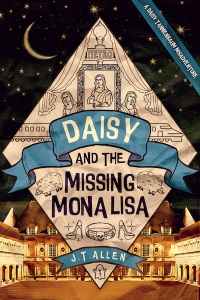11. Paris Death March II
Aug 11, 2019 by Mr. Allen
 We made our way down the rue Saint-Honoré, past designer shops and designer shoppers, flitting past the Elysée Palace, where the French president lives. Aunt Mill kept up her grueling pace and endless commentary. She had huge strides. I couldn’t quite match them, half jogging, half hopping to keep up, plus she weaved constantly, dodging window-gawkers and nose-to-iphone folks.
We made our way down the rue Saint-Honoré, past designer shops and designer shoppers, flitting past the Elysée Palace, where the French president lives. Aunt Mill kept up her grueling pace and endless commentary. She had huge strides. I couldn’t quite match them, half jogging, half hopping to keep up, plus she weaved constantly, dodging window-gawkers and nose-to-iphone folks. “So, Aunt Mill, are you looking for the diamonds or are you trying to figure out who killed Jeanne de la Motte?”
“Right now I’m just trying to break a series of coded messages. If I worry too much about the other stuff it gets in my way. You start wanting a certain answer and it clouds your judgment.”
“So who is the guy you’re doing this for?”
“Just a rich man who’s interested in history and wouldn’t mind being associated with a historic discovery, if one is made.”
“Does he have a name?”
“Mr. Smith.”
I crinkled my nose. She laughed. “He prefers to be anonymous.”
“How did you ever get into code breaking anyway?”
“I’m a mathematician, Daisy.”
“I thought you were a math teacher.”
“That too.”
Down Avenue de Marigny we marched, crossing the Champs Élysées, passing the Grand Palais and Petit Palais as Aunt Mill commented, “this whole area was developed for international exhibitions, that is, world fairs, to show off France’s industrial and artistic prowess, starting in the time of Louis Napoleon, around 1855. Before that, certainly before Napoleon Bonaparte’s time, west of the Place de la Concorde was pasture and village.”
We crossed the river once again, on the Pont Alexandre III, then marched into the park fronting Les Invalides, which, according to Aunt Mill, Louis XIV built to aid poor and wounded veterans.
“That was the king who bought the necklace for Madame du Barry?”
“No. That was Fifteen. This was Fourteen, the Sun King.”
“Sun King. Got it.”
Aunt Mill said Les Invalides had a great collection of military uniforms and even Napoleon’s stuffed horse, plus, around back, you could visit Napoleon’s tomb. She didn’t want to go near Napoleon’s tomb though. She thought it was disgusting. She maintained that Napoleon was like France’s version of Hitler—bloody, ruthless, causing death and destruction wherever he went, torturing dissenters, disappearing people—but he, “somehow managed to get himself deified.” She was quite angry over the whole Napoleon thing, like it happened just yesterday and affected her personally. “People love tyrants,” she said. “When Hitler came to tour Paris, after defeating the French in 1940, he made time to visit Napoleon’s tomb. Amazing how one tyrant, no matter his nationality, craves the memory of another.”
“Aunt Mill, how do you actually break a code?”
“Depends the code.”
“What kind of code is this one?”
“It’s a substitution code, combined with a complex nomenclature, with homophones to disrupt frequency analysis and, like Antoine Rossignol’s original code, it uses syllables rather than letters in the plain text.”
I must have looked perplexed, cause Aunt Mill laughed. “Do you know anythingabout codes, Daisy?”
“Iway ancay alktay inway igpay atinlay.”
She laughed again, then scrunched lips. “Let’s see, where to start? Antoine Rossignol was Louis the XIV’s code master.”
“The Sun King.”
“Right. Rossignol worked in what they called the black chamber at Versailles, coding and decoding diplomatic dispatches and breaking enemy codes. Rossignol’s son and grandson followed in the family trade, working for French kings down to the time of the Revolution. After that, the key to the codes were lost or forgotten and nobody could break the codes until Etienne Bazeries came along in the 1890s.
“Seems funny that they forgot their own codes.”
“Not really, when you consider there were three or four revolutions, several enemy occupations, and a few hundred years in between. France has a pretty tumultuous history.”
“You mean like, topsy-turvy.”
“I do.”
We came out the back side of Les Invalides, down Avenue de Tourville to the Champs des Mars, passing by the Ecole Militaire.
“Anyway,” she said, “there are a lot of different ways to code messages. One way is to shift letters around, like you just did in Pig Latin. Another is to replace the letters of a message with numbers. The trouble with that is that some letters, like E, T, A and N, appear in words frequently, while others, like Z and Q, hardly appear at all.”
“Is that why you get more points for Q in Scrabble?”
“Exactly why. And good code breakers, like the Rossignols, and two-hundred years later, Etienne Bazeries, knew exactly how many times, on average, each letter appeared. So one way of breaking a code is to compare a lot of messages and see how often certain letters appear, or, in other words, what their frequency is.”
“Is that what you’re doing?”
“Yes, partly. But it gets more complicated because, since the Rossignols knew this, instead of assigning a number to each letter, they assigned a number to each syllable, which changes the frequency of numbers the code breakers are looking for.”
“They sound pretty sneaky.”
“They were super-sneaky. Plus they figured out which syllables were used most, just like they figured out how many times E, T and A were used, and assigned several numbers to the most used syllables, to confuse enemy code breakers further.
“So the frequencies would be off.”
“Exactly. Then they threw in other tricks, like placing certain numbers in their code messages, called null numbers, that meant ‘disregard the number right before this,’ andassigning numbers to lists of commonly used words—Paris, London, the king, battleship, names of agents, things like that—to further confuse anyone trying to read their message.”
I shook my head, “And then they wrote all this in invisible ink too?”
“Right.”
“They seem really paranoid.”
“Well, since operating as a spy in an enemy country will get you hanged, they were just being precautious.”
By now we were walking in the Champ de Mars, toward the Eiffel Tower.
“Breaking a code sounds really complicated.”
“That’s what makes it fun. You have to build a framework, continually revise what you know, try out different theories base on what you think they’re communicating about, identify the nulls, build and rebuild algorithms.”
Even though it was a freezing cold day, there was a crowd of people at the Eiffel Tower. I said we didn’t have to go up because I had been up on top before, when I was a little kid, but Aunt Mill insisted, like it was a patriotic duty or something, and I was glad cause I really did want to go up. We got in line to buy tickets then got in line again to catch the elevator. The sun was already starting to go down. Aunt Mill tried to kill the wait by spouting more factoids—build in 1889, tallest building in the world till 1930s, supposed to be a temporary building, hated by Parisians when first built, scheduled to be blown up by Hitler when he evacuated Paris, his soldiers disobeyed.
I was frozen, starving, nose red, hands stiff, feet aching. Aunt Mill was still full of enthusiasm and energy. She must run on a plutonium battery pack. As we crammed into the elevator with everyone else, she was making a list of our next stops—Arc de Triomphe, Montparnassee, Val de Grâce, Jardin de Luxembourg, the Pantheon, Saint Germain, Arenes de Lucete, Jardin des Plantes, Place de la Bastilles.
“Aunt Mill, I’m not leaving tomorrow,” I said, voice more testy than I intended.
That quieted her down awhile. When we finally got out onto the observation deck, lights were coming on in the city. The wind was icy. Still, we stared out a long time, buffeted by people pushing to the rail or posing for photos. It seemed like, finally, Aunt Mill had run out of things to say.
“You know what I think?” I said.
“What?”
“I think the diamonds are still out there, just sitting in some hiding place, waiting for us to discover them.”
“Really, why?”
“I don’t know. I just do.”
“Maybe you’re right.”
“I’m always right on these things.”
She smiled and put a hand around my shoulder.
“Aunt Mill, can I help you crack the code?”
“You need to be good at math to crack codes.”
“I could get good. You could give me more homework.”

